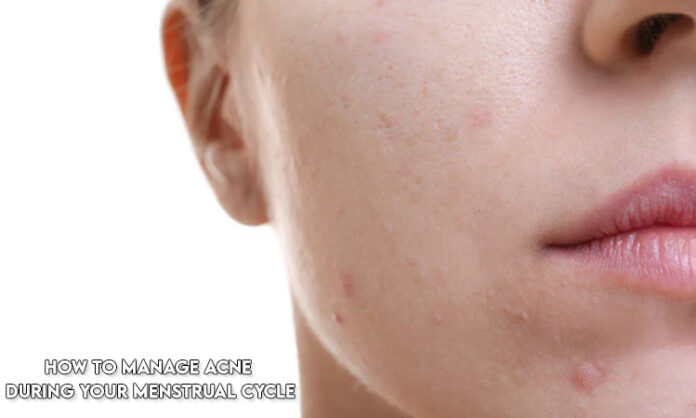Just when you think your skin is finally calming down, boom—your period shows up, and so do the breakouts. Sound familiar? You’re not alone.
Hormonal acne around the menstrual cycle is incredibly common. For many women, it’s a predictable monthly visitor that can be just as frustrating as cramps and mood swings. But the good news? Understanding why period acne happens can help you take steps to manage it before it shows up on your face.
In this guide, we’ll break down the science behind period acne, the best skincare practices to help manage it, and how to support your skin at every phase of your cycle.
What Causes Acne During Your Menstrual Cycle?
Let’s start with the basics: hormones.
Throughout your menstrual cycle, your hormones—especially estrogen and progesterone—rise and fall. Just before your period begins (typically in the luteal phase), estrogen dips while testosterone levels remain relatively higher. This hormonal shift causes your oil glands to ramp up production, leading to:
- Increased sebum (oil)
- Clogged pores
- Inflammation
- Breakouts, especially along the jawline and chin
This is what’s known as hormonal acne, and it often shows up 7–10 days before menstruation.
Signs of Menstrual Acne
Period-related acne tends to have a few telltale signs:
- Deep, painful cysts (not just surface-level pimples)
- Located around the jawline, chin, and cheeks
- Appears consistently around the same time each month
- May last longer or leave behind dark marks or scars
If this sounds like your skin every month, your menstrual cycle is likely the culprit.
Skincare Tips to Manage Menstrual Acne
Let’s walk through a cycle-based skincare approach to help you stay ahead of those hormonal breakouts.
- Week 1: Menstruation Phase (Days 1–5)
Your period has started, hormones are low, and skin is more sensitive.
What to do:
- Keep your routine simple: Use gentle, hydrating cleansers and lightweight moisturizers.
- Avoid harsh actives: Your skin may feel drier or more reactive, so skip strong acids or retinoids.
- Hydrate and nourish: Use products with ceramides, hyaluronic acid, or aloe vera to support the skin barrier.
- Week 2: Follicular Phase (Days 6–14)
Estrogen starts to rise, and your skin is usually at its best—bright, clear, and balanced.
What to do:
- Introduce light exfoliation: Use salicylic acid or glycolic acid 2-3 times this week to help keep pores clear.
- Maintain oil balance: Niacinamide is your friend—it regulates sebum and soothes inflammation.
- Prep for what’s coming: Consider adding calming or clarifying masks mid-week to stay ahead of sebum build-up.
- Week 3: Ovulation Phase (Around Day 14)
Hormones are peaking. Your skin is still glowing, but oil production may start to increase.
What to do:
- Use non-comedogenic products: Swap thick creams for gel-based moisturizers.
- Double cleanse at night: Helps remove sunscreen, sweat, and makeup without clogging pores.
- Spot treat: If you feel a pimple brewing, spot-treat with benzoyl peroxide or sulfur.
- Week 4: Luteal Phase (Days 15–28)
Testosterone becomes dominant, oil increases, and breakouts tend to appear.
What to do:
- Go proactive: Begin using ingredients like retinoids, azelaic acid, or salicylic acid at night before breakouts appear.
- Target inflammation: Use calming products with green tea extract, zinc, or centella asiatica (cica).
- Hydrate strategically: Don’t skip moisturizer. Even acne-prone skin needs moisture—just use a lightweight, oil-free formula.
Lifestyle Tips to Support Skin During Your Cycle
Skincare alone won’t always stop hormonal acne. Your overall lifestyle plays a major role too.
🥗 1. Watch What You Eat
Certain foods may worsen inflammation or trigger hormonal shifts.
Try to avoid:
- Sugary snacks
- Dairy (especially skim milk)
- Refined carbs
Instead, eat more:
- Leafy greens
- Omega-3-rich foods (salmon, chia seeds)
- Antioxidants (berries, nuts, green tea)
💤 2. Get Enough Sleep
Lack of sleep increases stress and cortisol, which can lead to flare-ups. Aim for 7–9 hours of restful sleep per night.
🧘♀️ 3. Manage Stress
Stress hormones like cortisol can increase oil production and worsen acne. Try journaling, yoga, deep breathing, or simply unplugging for 15 minutes a day.
💊 4. Consider Hormonal Support (Talk to a Doctor)
In some cases, oral contraceptives or anti-androgen medications may help regulate hormonal fluctuations and reduce acne. Always consult with a dermatologist or gynecologist before starting any medication.
Natural Remedies for Menstrual Acne (Optional Add-Ons)
If you’re into holistic skincare, a few natural remedies may help soothe period breakouts:
- Warm compresses for painful cysts
- Honey + cinnamon masks for antibacterial action
- Green tea toner for calming inflamed skin
- Aloe vera gel for healing red spots
Note: While natural remedies can be helpful, they shouldn’t replace proven acne treatments if your acne is moderate to severe.
When to See a Dermatologist
If your hormonal acne is:
- Persistently painful
- Causing scarring
- Not responding to over-the-counter treatments
…then it’s time to see a professional. A dermatologist can offer prescription-strength solutions like topical retinoids, spironolactone, or hormone therapy.
Quick-Glance Summary: Skincare for Your Menstrual Cycle
| Cycle Phase | Skin State | Key Actions |
| Menstruation | Sensitive, dry | Hydrate, soothe, avoid actives |
| Follicular | Balanced, clear | Gentle exfoliation, prep skin |
| Ovulation | Glowy, slight oil | Double cleanse, spot treat |
| Luteal | Oily, breakout-prone | Retinoids, clarify, calm skin |
